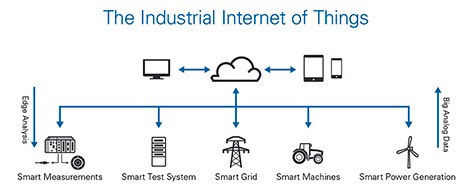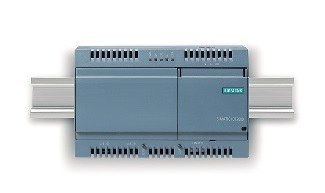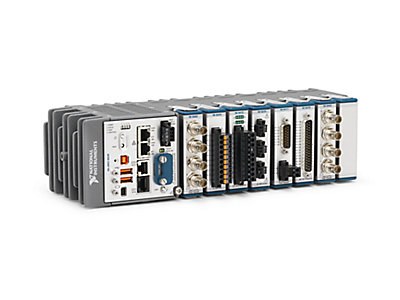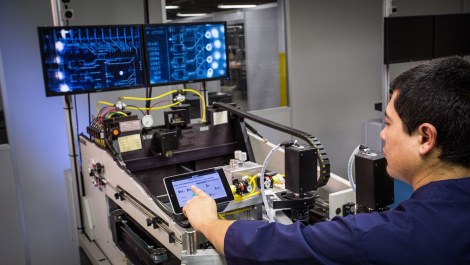Tired of the countless articles talking about the Industrial Internet of Things (IIoT)? Surely all the gurus, industry leaders, and technology vendors excited to share their perspective on the growing impact of the IIoT have exhausted the topic. Instead of focusing on what the IIoT is, this article takes the opposite approach and talks about what the IIoT is not. To be honest, the IIoT is not defined. It is not a known target with a clear set of parameters and rules. One thing we do know, however: as we build and define the IIoT, it is critical that vendors oversize their technology offerings for flexibility.
The moving target that is the IIoT
Industry giants have formed consortia to review the foundational technology on which the IIoT will be built and to define the standards that will facilitate future communication protocols. The Industrial Internet Consortium (IIC) has established three active testbeds with Bosch, Cisco, NI and Tech Mahindra to explore control and monitoring in the Factory of the Future; Cisco, NI and Real Time Innovations for microgrid; and EMC and Cork Institute of Technology for INFINITE. The Open Interconnect Consortium (OIC) is where companies like GE, Intel, and Samsung are collaborating to ensure connectivity between these evolving standards.
As these issues are actively being defined, the existing legacy fleet of systems, machines and infrastructure still needs to evolve to incorporate these standards and protocols.
How do you do that? Flexible software is the answer
Software will define the IIoT
Perhaps the most tangible change in the way systems will be designed in the future is the evolution of the role and importance of software. The starting point behind the intelligence is holistically dependent on the software. Without software, the hardware is “mute”. The physical interface is the entity that allows the action—by activating an actuator or closing a valve—but the software processes information to make the decision that performs the action itself. Consider the deployment of an airbag in your car. It's not about the fancy design of physical switches that activate a lever to deploy the air. It is a software algorithm that activates the actuator.
Regardless of industry, market, or product, every company will become a software company.
In the consumer market, software-defined systems have already proven to bring much more benefits through a greatly improved user experience.
Products that were once very generic, such as phones, light bulbs, and watches, are now selling at huge profits due to a software interface that adds a better user experience, value through data connectivity, and an open ecosystem that delivers value. peripheral well beyond the capabilities of the provider. Software is reinventing hardware in a number of ways.
It is time for the world's machines and infrastructure to do the same. From power grids to manufacturing factories to heavy machinery, the macroeconomic value and impact of connecting these data sources together is too good to forget. Although the challenge is clear, the way to do it is not. The traditional design approach is defined by separate teams running different software tools that lack the sophistication to interoperate. The design times of 10 years ago allowed for a lack of speed in this design cycle. However, today's time-to-market pressure coupled with the acceleration in the definition of communications standards makes this design vision outdated.
Enter the software platform.
Defining systems with a software platform
The market is full of amazing tools that have proven their worth over the years. These products, such as TwinCAT, MATLAB®, or LabVIEW, have offered innovative functionality that has benefited engineers and scientists. However, the market lacks a real software platform to enable the next wave of innovation at a pace we simply haven't seen.
More than individual tools to solve a particular challenge, a software platform is a unique combination of capabilities, protocols, development techniques, and hardware interface APIs. The key to the platform is the nature of this combination. The platform presents users with the collective power of these components, but is built in a way that components can be individually extended, upgraded, and easily innovated upon. In other words, the platform offers great flexibility.
The undefined, constantly moving, and always evolving nature of the IIoT requires this flexibility. Any single vendor-defined tool that claims to be the answer is simply the wrong one.
The flexibility of a software platform helps engineers tackle the most daunting aspects of IIoT: latency, device synchronization, security, upgradeability, advanced control, and end-to-end data analysis. As with intelligent decision making, each of these challenges occurs at each layer of a system of systems. Distributed networks of intelligent nodes, connected networks of intelligent machines, even fully connected factories must solve these difficulties in a way that can be changed, upgraded and improved in six months, two years or five years, as new standards are defined and requirements.
Ultimately, products built from a software platform will be the interface engineers use to solve these challenges. However, the software platform itself—the foundational infrastructure—will be the building block that defines the products. A unique value of the platform is the ability to customize components of that delivered product for the specific needs of the problem. In Crossing the Chasm, Geoffrey Moore described this as “vendors need to dress their platforms in app clothing”. Just like the Betamax, cassette tapes and Internet access dialing, cassette tapes and general tools from the 60's will be a thing of the past. The market requires the specificity of the tool so that the difficulties are addressable and even solvable.
Industry's only engineering software platform
In the race to define the technologies on which the IIoT will be built, the company that thinks of the engineer who creates and defines the next generation of products used to design, manufacture and test the connected machines will be the company that wins. NI is building the industry's only true software platform. The fruit of 30 years of investment in LabVIEW software and other engineering-focused software products, the NI software platform will be the technology that connects engineers to the IIoT. From this software platform will emerge software products created to solve concrete problems of the largest network of connected systems. Delivering landmark productivity benefits to leading researchers such as Nokia and Samsung, the LabVIEW Communications Suite is holistically built on this platform and “dressed” with wireless prototyping application needs. And this is just the beginning. The question will not be “why use the NI software platform to solve the IIoT?” The question will be "how could I not?"







